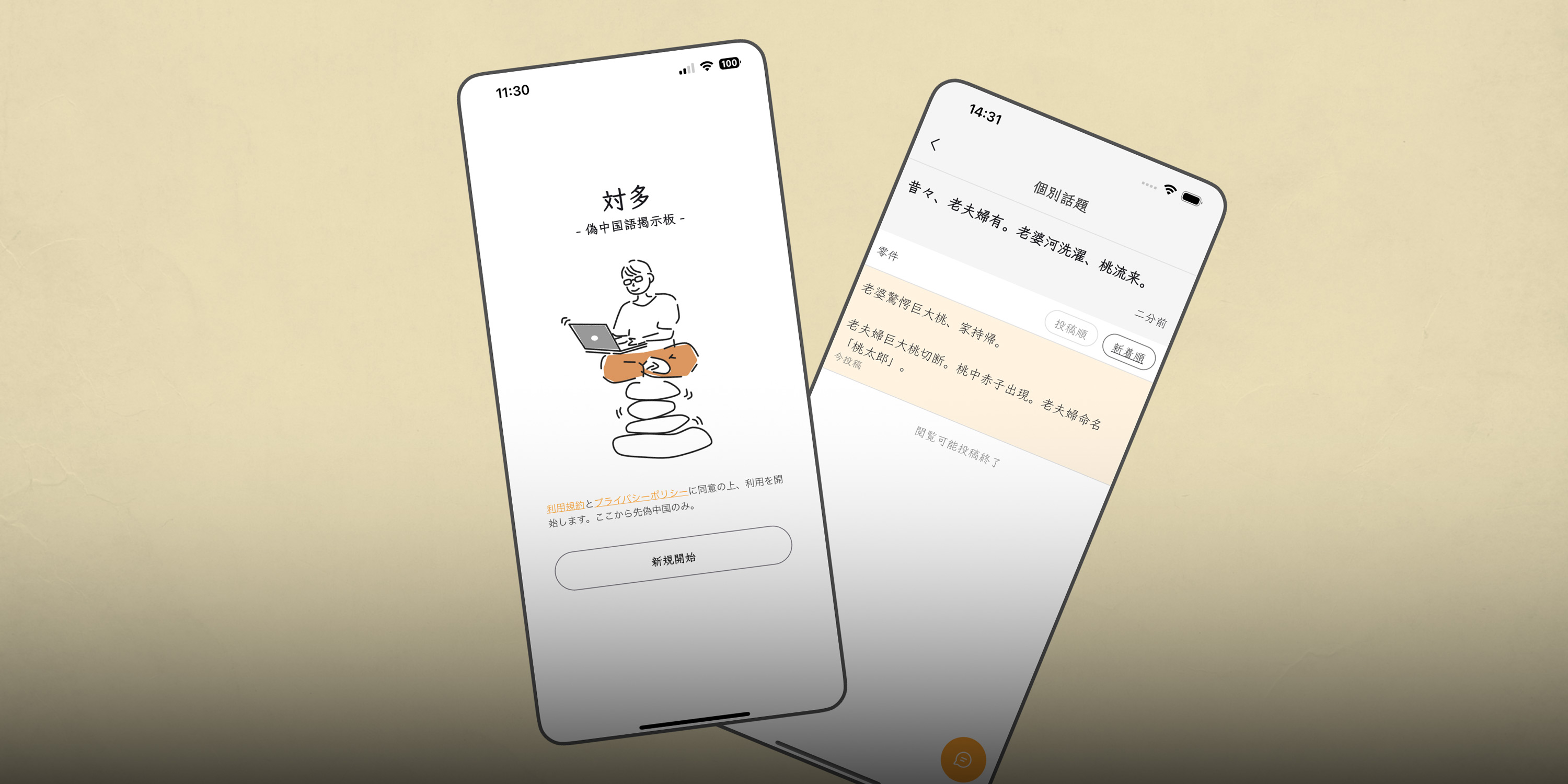
The Japanese App Where Everyone Speaks Chinese (But Not Really)
In December 2024, a solo Japanese software developer known as asa quietly uploaded a new program to the Apple and major Android app stores. Called Tsuita, it’s essentially an ultra-simple online platform with just a single, rudimentary function: allowing users to post short, text-only messages.
That lack of functionality didn’t deter users, however: Following in the footsteps of other trendy stripped-down apps, such as BeReal, Tsuita recorded a massive surge in downloads shortly after its launch, with so many users signing up that asa had to temporarily suspend services. As of February, Tsuita has over 3,500 reviews and a 4.8 rating on the Japanese iOS store.
What made Tsuita so popular was its one, strange rule: Users can only type in “pseudo-Chinese.” Put simply, if modern Japanese is a composite system of a mix of native phonetic scripts (hiragana and katakana) and ideograms (kanji) derived from Chinese characters, pseudo-Chinese is solely kanji. The resulting sentences bear a superficial resemblance to Chinese, but their Japanese grammar makes them all but indecipherable to Chinese readers. (Imagine trying to communicate with an ancient Roman by adding Latin endings to English words.)
Pseudo-Chinese has been floating around the Japanese internet since the early 2000s. But its recent popularity can be traced to the 62-year-old former Japanese cabinet minister — and prolific poster — Kono Taro. In 2019, while serving as Japan’s Minister for Foreign Affairs, Kono — who has expressed frustration over his repeated failures to learn Chinese — posted a message on his personal Twitter account using pseudo-Chinese: “Had lunch and talked with important people in the Chinese foreign affairs field; packed luggage, going home.”
While the post reads smoothly enough in English translation, Chinese readers saw mostly gibberish: “Knowledgeable people in Chinese foreign affairs day eat talk meeting, packages built, return to country.” Nevertheless, the joke landed. This, Kono seemed to be saying, was the best he could do, so why not meet him halfway?
For Japanese, pseudo-Chinese lands in a sweet spot between familiar and strange — the legacy of centuries of cultural exchange between the two countries. Japan had no written language until the 6th or 7th centuries CE, when Chinese characters were introduced on a large scale. Due to significant differences in pronunciation and grammar between Japanese and Chinese, however, Japan gradually developed new phonetic notation systems, including manyogana, hiragana, and katakana.
The Japanese language today is made up of a composite system of hiragana, katakana, and kanji. According to an official “List of Regular-Use Kanji” released by the Japanese government in 2010, there are 2,136 commonly used kanji in modern Japanese. Though their declining importance and distance from spoken Japanese mean that even these commonly used characters are not always understood or used — a fact that Japanese films, television programs, and entertainers frequently use to comic effect.
Chinese speakers, too, feel a mixture of familiarity and strangeness when encountering pseudo-Chinese. To start, the use of Japanese syntax in pseudo-Chinese makes it difficult for Chinese users to follow. For example, when the developer asa announced the launch of the Tsuita app on their website, they wrote in pseudo-Chinese: “I, pseudo-Chinese display board created. Name Tsuita.” (The name itself is a pseudo-Chinese pun on X, the app formerly known as Twitter.)
Second, although Japanese characters and Chinese characters share a common origin, their parallel development paths mean that the same character may have evolved different meanings in Japanese and Chinese. For instance, the commonly used kanji “da zhangfu” means “no problem” in Japanese — but Chinese unfamiliar with Japanese would likely interpret it to mean “a real man.”
Professor Nakada Norio, an authority on the Japanese language, once likened Japanese kanji and Chinese to seawater and freshwater: “The difference between seawater and freshwater is manifested in the presence or absence of only 2.4% salt, but this small difference in salt content results in the huge difference between marine and freshwater organisms.” When Chinese people encounter pseudo-Chinese text, they cannot assume they understand the author’s meaning, even if it appears clear.
This difficulty did not stop Tsuita from becoming a hit in China, however. In an interview with Japanese media, asa stated that they developed Tsuita purely out of personal interest. Originally, they thought that only a few dozen like-minded people would sign up. But the app has far exceeded expectations — especially in the way it has drawn in curious Chinese, a trend comparable to the surge in interactions between Chinese and Americans on RedNote, known as Xiaohongshu in China.
These curious Chinese users are far from the first to attempt to take advantage of kanji to communicate across the East China Sea. When the reformer Liang Qichao fled into exile in Japan over a century ago, he published a language guide for the Chinese diaspora that claimed “80% to 90% of Japanese is in Chinese characters.” That was an overstatement, as even other Chinese intellectuals of the era noted, but the dream of a reunified linguistic sphere encompassing the entirety of East Asia clearly retains its allure.
The app has also drawn renewed interest in kanji in Japan. Although kanji literacy is a necessity for most, true fluency and confidence remain elusive. Tsuita’s innovation was to make kanji literacy fun again: a puzzle that can be solved if only they find the right combination.
And that’s ultimately what matters most. After all, as Sasahara Hiroyuki, a professor at Waseda University, wrote in his 2006 book “Kanji in Japan,” “Since studying it (kanji) is inexhaustible, it is better to memorize as many kanji as possible for entertainment, and have fun with the arduous process.”
Translator: Matt Turner; editor: Cai Yineng.
(Header image: Visuals from Google Play, reedited by Sixth Tone)










